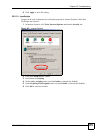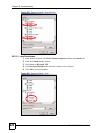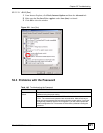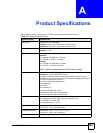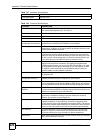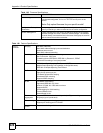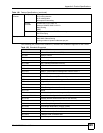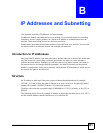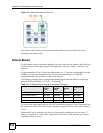
Appendix A Product Specifications
GS-4012F/4024 User’s Guide
426
Power Wire Gauge 18 AWG or larger
Fuse Specification 250 VAC, T2A
Table 148 Firmware Specifications
FEATURE DESCRIPTION
Default IP Address In band: 192.168.1.1
Out of band (Management port): 192.168.0.1
Default Subnet Mask 255.255.255.0 (24 bits)
Administrator User Name admin
Default Password 1234
Number of Login Accounts
Configurable on the Switch
4 management accounts configured on the Switch.
Authentication via RADIUS and TACACS+ also available.
IP Routing Domain An IP interface (also known as an IP routing domain) is not bound to a
physical port. Configure an IP routing domain to allow the Switch to route
traffic between different networks.
VLAN A VLAN (Virtual Local Area Network) allows a physical network to be
partitioned into multiple logical networks. Devices on a logical network
belong to one group. A device can belong to more than one group. With
VLAN, a device cannot directly talk to or hear from devices that are not
in the same group(s); the traffic must first go through a router.
VLAN Stacking Use VLAN stacking to add an outer VLAN tag to the inner IEEE 802.1Q
tagged frames that enter the network. By tagging the tagged frames
(“double-tagged” frames), the service provider can manage up to 4,094
VLAN groups with each group containing up to 4,094 customer VLANs.
This allows a service provider to provide different service, based on
specific VLANs, for many different customers.
MAC Address Filter Filter traffic based on the source and/or destination MAC address and
VLAN group (ID).
DHCP (Dynamic Host
Configuration Protocol)
Use this feature to have the Switch assign IP addresses, an IP default
gateway and DNS servers to computers on your network.
IGMP Snooping The Switch supports IGMP snooping, enabling group multicast traffic to
be only forwarded to ports that are members of that group; thus allowing
you to significantly reduce multicast traffic passing through your Switch.
Differentiated Services
(DiffServ)
With DiffServ, the Switch marks packets so that they receive specific
per-hop treatment at DiffServ-compliant network devices along the route
based on the application types and traffic flow.
Classifier and Policy You can create a policy to define actions to be performed on a traffic flow
grouped by a classifier according to specific criteria such as the IP
address, port number or protocol type, etc.
Queuing Queuing is used to help solve performance degradation when there is
network congestion. Three scheduling services are supported: Strict
Priority Queuing (SPQ) and Weighted Round Robin (WRR). This allows
the Switch to maintain separate queues for packets from each individual
source or flow and prevent a source from monopolizing the bandwidth.
Port Mirroring Port mirroring allows you to copy traffic going from one or all ports to
another or all ports in order that you can examine the traffic from the
mirror port (the port you copy the traffic to) without interference.
Static Route Static routes tell the Switch how to forward IP traffic when you configure
the TCP/IP parameters manually.
Table 147 Hardware Specifications




